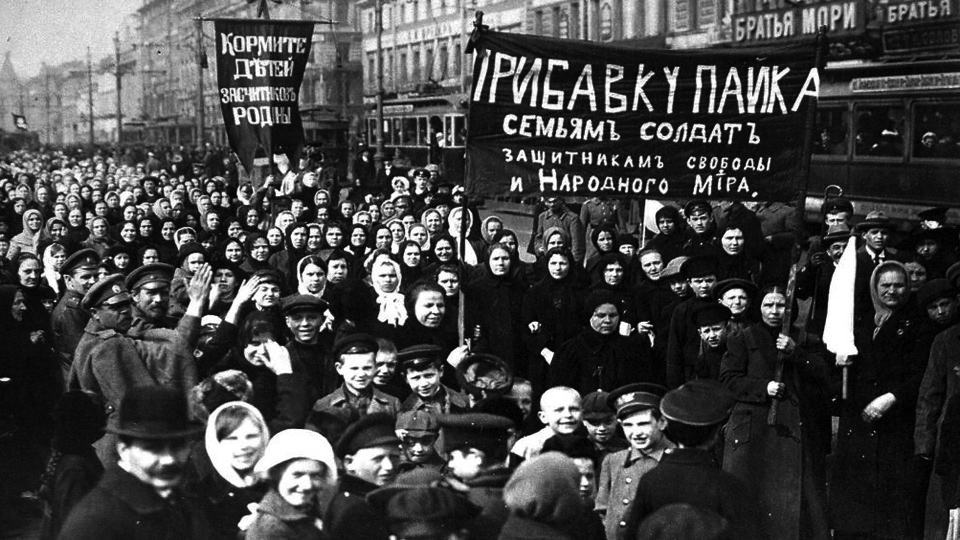
The Centennial of the Russian Revolution
November 7, 2017 marks the 100th anniversary of the Russian Revolution and the establishment of the world’s first socialist state. To commemorate the occasion, People’s World is presenting a series of articles that present wide-angled assessments of the revolution’s legacy, the Soviet Union and world communist movement which were born out of it, and the revolution’s relevance to radical politics today. Proposals for contributions are welcome and should be emailed to cjatkins@peoplesworld.org. Other articles in the series can be read here.
The 2017 centenary of the Russian Revolution has triggered a great deal of interest, not all of which is helpful or illuminating. However, one aspect of the two revolutions of 1917 which has been almost completely disregarded is the role of women.
 The commonly accepted view is that Russian women featured only twice in 1917. The first time was in Petrograd on February 23 as harbingers of the revolution which established the Provisional Government that took over after the abdication of Czar Nicholas II.
The commonly accepted view is that Russian women featured only twice in 1917. The first time was in Petrograd on February 23 as harbingers of the revolution which established the Provisional Government that took over after the abdication of Czar Nicholas II.
The second time, bourgeois women played a reactionary role as part of a battalion defending the Winter Palace, the seat of government, against an attack by Lenin’s Bolsheviks on October 25.
Both these events occurred, but lazily citing only them fails to do justice to the enormously important role of women throughout the revolutionary process as “midwives of the revolution”—to quote the title of Jane McDermid and Anna Hilyar’s book. They were present at the birth and were crucial in the final stages of delivery. In addition, they played a vital role in defending the revolution during the Russian civil war of 1919-20.
In order to appreciate the role of women, it is necessary to go back to the 1905 revolution in Russia when the feminist movement first took off with the formation of the League for Women’s Equality.
In common with many similar organizations in Europe at the time, this one concentrated on women’s suffrage and comprised mainly bourgeois women. However, Clara Zetkin in Germany understood that women were divided on class lines and recognized the need for working class women to fight on their own account. As she put it in 1907 at the International Socialist Women’s Conference in Stuttgart, “Class contradictions exclude the possibility of working women becoming allies of the bourgeois feminist movement.
“This does not mean that they reject bourgeois feminists if the latter, in the struggle for universal female suffrage, should stand by them in fighting the common enemy on different fronts.”
This message was taken up in Russia by Konkordiya Samoilava, Alexandra Kollontai, and many other Bolshevik women who, in 1907, formed the Working Women’s Mutual Assistance Center in order to spread socialist ideas among working class women, to encourage women to join the now legal trade unions, and also to ensure that the socialist movement did not continue to ignore women’s issues.
Although International Women’s Day was inaugurated in 1910, it was not celebrated in Russia until 1913.
Lenin actively supported campaigning among working women and was among those who advocated the publication of a new paper, Rabotnitsa (The Woman Worker), which first appeared in 1914.
The outbreak of World War I in that year served as a major brake on labor movement activities and, as elsewhere in Europe, accentuated the left/right divisions among socialists.
This was very apparent in Russia where the Russian Social Democratic and Labor Party (RSDLP) had already split in 1903 into Bolshevik (majority) and Menshevik (minority) factions; but the division was even more irreconcilably bitter given the latter’s support for the war, in contrast to the popular anti-war policy of the Bolsheviks.
The issue of support vs. opposition to the war similarly accentuated the class divisions in the already fractured women’s movement.
The bourgeois feminist movement supported the war, whereas working women, influenced by their Bolshevik sisters, were increasingly opposed to WWI.
By 1917, a vast number of women were working in factories, both in munitions and replacing conscripted men. On February 23, 1917 (March 8 in our modern Gregorian calendar), International Women’s Day was marked by strikes and huge demonstrations of women.
The Bolshevik paper Pravda reported that this led to revolution: “…the first day of the revolution was Women’s Day… the women… decided the destiny of the troops; they went to the barracks, spoke to the soldiers, and the latter joined the revolution… Women, we salute you.”
However, contrary to the traditional view, this was only the beginning of working women’s involvement in the revolutionary process. For bourgeois feminists, it marked the end.
The latter steadfastly supported the new Provisional Government led by first Georgi Lvov and then Alexander Kerensky and, although still campaigning for the vote, their chief demand was “war to victory.”
It was from these pro-war women that the Women’s Battalion was formed to fight both the Germans and the Bolsheviks.
Women workers by this time were totally opposed to the war, the government, and the presumption that bourgeois women could speak on their behalf. Thus strike action continued, even among hard to organize service workers. For example, in March 1917, laundry workers, led by a Bolshevik, Sofia Goncharskya, struck for four weeks.
In April 1917, 100,000 soldiers’ wives staged a march and demonstration demanding better rations and an end to the war. Kollontai addressed their rally.
Bolsheviks were heavily engaged in agitational work among women assisted by the reappearance of the paper Rabotnitsa, which came out several times a month with a circulation of 40-50,000. Nadezhda Krupskaya (Lenin’s wife) and Inessa Armand were among those on the editorial board.
Women workers were actively involved in opposing General Lvar Kornilov’s attempted military coup in August; they helped build barricades and “Red Sisters” organized medical assistance.
In September, Samoilava organized the first formal conference of women workers—it was reconvened after the October Revolution.
During and after the revolution, very many women were enrolled as Red Guards in a variety of roles, including as combatants.
As testimony to the importance of women in the revolutionary period, one of the first decrees of the socialist government after it came to power was the revision of family and divorce law in December 1917, buttressed less than a year later by the Code on Marriage and the Family (October 1918). This encapsulated a revolutionary vision of social relations based on women’s equality.
Women’s role in the Russian Revolution is best summed up by Lenin, who in conversation with Clara Zetkin in 1920 said: “Women workers acted splendidly during the revolution. Without them we should not have been victorious.” Now, 100 years on, these words should be a salient reminder of women’s revolutionary role.












Comments